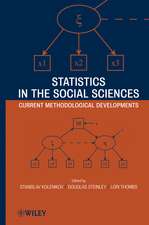Metric Scaling: Correspondence Analysis: Quantitative Applications in the Social Sciences, cartea 75
Autor Susan C. Weller, A. Kimball Romneyen Limba Engleză Paperback – 10 oct 1990
Din seria Quantitative Applications in the Social Sciences
-
 Preț: 323.09 lei
Preț: 323.09 lei -
 Preț: 285.10 lei
Preț: 285.10 lei -
 Preț: 285.33 lei
Preț: 285.33 lei -
 Preț: 274.06 lei
Preț: 274.06 lei -
 Preț: 285.37 lei
Preț: 285.37 lei -
 Preț: 321.52 lei
Preț: 321.52 lei -
 Preț: 330.81 lei
Preț: 330.81 lei -
 Preț: 322.61 lei
Preț: 322.61 lei -
 Preț: 321.79 lei
Preț: 321.79 lei -
 Preț: 323.15 lei
Preț: 323.15 lei -
 Preț: 273.46 lei
Preț: 273.46 lei -
 Preț: 275.42 lei
Preț: 275.42 lei -
 Preț: 277.33 lei
Preț: 277.33 lei -
 Preț: 322.06 lei
Preț: 322.06 lei -
 Preț: 286.18 lei
Preț: 286.18 lei -
 Preț: 285.71 lei
Preț: 285.71 lei -
 Preț: 322.06 lei
Preț: 322.06 lei -
 Preț: 321.52 lei
Preț: 321.52 lei -
 Preț: 322.30 lei
Preț: 322.30 lei -
 Preț: 285.47 lei
Preț: 285.47 lei -
 Preț: 322.61 lei
Preț: 322.61 lei -
 Preț: 321.79 lei
Preț: 321.79 lei -
 Preț: 323.15 lei
Preț: 323.15 lei -
 Preț: 323.36 lei
Preț: 323.36 lei -
 Preț: 322.41 lei
Preț: 322.41 lei -
 Preț: 323.42 lei
Preț: 323.42 lei -
 Preț: 322.61 lei
Preț: 322.61 lei -
 Preț: 284.99 lei
Preț: 284.99 lei -
 Preț: 285.47 lei
Preț: 285.47 lei -
 Preț: 284.99 lei
Preț: 284.99 lei -
 Preț: 289.18 lei
Preț: 289.18 lei -
 Preț: 287.82 lei
Preț: 287.82 lei -
 Preț: 316.12 lei
Preț: 316.12 lei -
 Preț: 288.96 lei
Preț: 288.96 lei -
 Preț: 316.71 lei
Preț: 316.71 lei -
 Preț: 314.98 lei
Preț: 314.98 lei -
 Preț: 317.26 lei
Preț: 317.26 lei -
 Preț: 314.60 lei
Preț: 314.60 lei -
 Preț: 289.95 lei
Preț: 289.95 lei -
 Preț: 289.18 lei
Preț: 289.18 lei -
 Preț: 315.36 lei
Preț: 315.36 lei -
 Preț: 314.98 lei
Preț: 314.98 lei -
 Preț: 314.38 lei
Preț: 314.38 lei -
 Preț: 316.33 lei
Preț: 316.33 lei -
 Preț: 316.51 lei
Preț: 316.51 lei -
 Preț: 314.76 lei
Preț: 314.76 lei -
 Preț: 288.41 lei
Preț: 288.41 lei -
 Preț: 316.51 lei
Preț: 316.51 lei
Preț: 289.18 lei
Nou
Puncte Express: 434
Preț estimativ în valută:
55.34€ • 58.19$ • 45.72£
55.34€ • 58.19$ • 45.72£
Carte tipărită la comandă
Livrare economică 17 aprilie-01 mai
Preluare comenzi: 021 569.72.76
Specificații
ISBN-13: 9780803937505
ISBN-10: 0803937504
Pagini: 96
Ilustrații: 1, black & white illustrations
Dimensiuni: 140 x 216 x 6 mm
Greutate: 0.12 kg
Ediția:1
Editura: SAGE Publications
Colecția Sage Publications, Inc
Seria Quantitative Applications in the Social Sciences
Locul publicării:Thousand Oaks, United States
ISBN-10: 0803937504
Pagini: 96
Ilustrații: 1, black & white illustrations
Dimensiuni: 140 x 216 x 6 mm
Greutate: 0.12 kg
Ediția:1
Editura: SAGE Publications
Colecția Sage Publications, Inc
Seria Quantitative Applications in the Social Sciences
Locul publicării:Thousand Oaks, United States
Cuprins
Introduction
The Basic Structure of a Data Matrix
Principal Components Analysis
Multidimensional Preference Scaling
Correspondence Analysis of Contingency Tables
Correspondence Analysis of Non-Frequency Data
Ordination, Seriation, and Guttman Scaling
Multiple Correspondence Analysis
The Basic Structure of a Data Matrix
Principal Components Analysis
Multidimensional Preference Scaling
Correspondence Analysis of Contingency Tables
Correspondence Analysis of Non-Frequency Data
Ordination, Seriation, and Guttman Scaling
Multiple Correspondence Analysis
Notă biografică
Dr. Weller¿s PhD is in Social Science and her expertise is in the area of research methods (statistics, epidemiology, and data collection). She is skilled in both qualitative and quantitative methods. She has two books on methods: Systematic Data Collection (Sage Pub) covers a wide variety of interviewing and data collection methods and Metric Scaling (Sage Pub.) covers multivariate techniques of principal components, multidimensional scaling, and correspondence analysis. For over a decade, she has been the co-director and a teacher in the National Science Foundation¿s Summer Institute for Research Design. Her research interests focus on minority health issues with a focus on the measurement of beliefs. She is the co-developer of the Cultural Consensus Model (Romney, Weller, &Batchelder 1986; Romney, Batchelder, & Weller 1987; Weller 2007), a formal mathematical model for the assessment of cultural beliefs. Her research (funded by NSF) concerns the measurement of beliefs and practices among Latinos in Guatemala, Mexico, South Texas, and Connecticut. Papers include studies of Latino beliefs about AIDS/SIDA, diabetes, asthma, the common cold, and folk illnesses, as well as comparisons between community and physician beliefs on AIDS, diabetes, and the common cold. Research on diabetes also has examined the effectiveness of diabetes screening guidelines using the NHANES data (in the Proceedings of the National Academy of Sciences, Dallo& Weller 2003). She is also the co-author on the meta-analysis of condom effectiveness for sexually transmitted HIV (Davis & Weller 1999; Weller & Davis 2001) and served on the federal consensus panel to summarize research concerning condoms and sexually transmitted diseases. Current work concerns decision-making of Galveston residents when asked to evacuate for hurricane Ike. Another project is examining beliefs about the common cold and H1N1 flu in the US and Mexico.
Descriere
This book presents a set of closely-related techniques that facilitate the visual exploration and display of a wide variety of multivariate data, both categorical and continuous. Three methods of metric scaling - correspondence analysis, principal components analysis and multiple dimensional preference scaling - are explored in detail for their strengths and weaknesses over a wide range of data types and research situations. The book focuses upon representing the relations among two or more sets of variables, and upon applications that are exploratory in nature rather than predictive.













